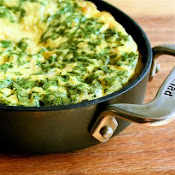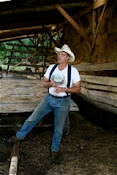
On Wednesday November 8, in his New York Times column, “The Minimalist,” Mark Bittman enthusiastically describes a no-knead bread making process. I’ve discovered that his enthusiasm was not unwarranted. Since reading the article, I’ve made the bread twice, and both times have been very pleased with the results. A rustic boule emerges from the oven truly appearing as though it had been produced in a professional bakery. The crust is thin and crisp and the interior moist and airy. It is dramatic and beautiful and comfortably feeds ten people for dinner. The next day, it makes delicious toast and sandwich bread, and moreover freezes beautifully. I’ve adjusted the recipe by adding a touch more salt than suggested in the article, and adding a half a teaspoon of sugar, which I think has markedly improved the bread’s flavor. Be sure to read the recipe through entirely before endeavoring to make this bread: you need 12-18 hours initially in rising time and 2 more hours subsequently for a second rise.
No-Knead Bread
Adapted from “The Minimalist,” The New York Times: Dining In
November 8, 2006
3 cups bread flour, plus more for dusting
¼ tsp. instant yeast
1¾ tsp. table salt
½ tsp. sugar
Cornmeal, wheat bran or oat bran as needed
In a large bowl, combine flour, yeast, salt and sugar. Add 1 and 5/8 cups water, and stir until blended. Dough will be sticky. Cover bowl with plastic wrap and let rest 12-18 hours at room temperature.
After the 12 hours, or when the surface of the dough is dotted with bubbles, lightly flour a work surface and place dough on it. Sprinkle a little more flour on the dough and fold it over on itself once or twice. Cover loosely with plastic wrap and let rest about 15 minutes.
Meanwhile, lay a clean kitchen towel (not terry cloth) on a counter or tabletop in a draft-free area. Generously coat it with cornmeal, wheat bran, oat bran or any combination of the three. After the 15 minutes, using as much flour as necessary to keep dough from sticking to your fingers and the work surface, quickly shape the dough into a ball and place seam side down in the center of the prepared towel. Dust with more cornmeal, wheat bran or oat bran. If the towel is large enough, fold the sides up over the bread so that it is completely covered. If the towel is too small, cover with another towel. Let rise for another 2 hours.
Forty-five minutes before the dough is ready, preheat the oven to 450°F. Place a 6- to 8-quart heavy covered pot (cast iron, enamel, Pyrex or ceramic: I’ve used a ceramic Emile Henry Dutch oven and a circular Pyrex baking dish) on a rimmed sheet pan and place in the oven while it heats. When dough is ready, carefully remove pan and pot from oven. Slide your hand under towel and turn dough over into pot, seam side up. This is tricky. The first time I made this I clumsily flopped the dough into the pot and it lay seam side down. If this happens, just leave it: there is no way to fix it without burning yourself, and it ultimately does not matter. So, try your best to let the dough fall seam side up, and don’t worry and if it lands seam side down. Cover with lid and bake 30 minutes. Remove lid and bake another 15-30 minutes or until it sounds hollow when tapped. Remove from oven, and turn out onto a cooling rack. This makes a mess. Placing the cooling rack inside another rimmed sheet pan helps catch the crumbs that fall out of the baking vessel. Enjoy!


































































































































